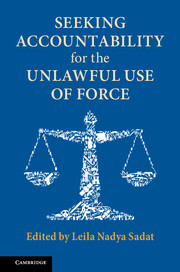Book contents
- Frontmatter
- Dedication
- Contents
- Notes on Contributors
- Foreword
- Preface
- Table of Cases
- Introduction
- PART I HISTORIC AND CONTEMPORARY PERSPECTIVES ON THE UNLAWFUL USE OF FORCE
- PART II MECHANISMS FOR RESTRAINING THE UNLAWFUL USE OF FORCE AND ENHANCING ACCOUNTABILITY
- PART III THE ILLEGAL USE OF FORCE AND THE PROSECUTION OF INTERNATIONAL CRIMES
- PART IV IMAGINING A BETTER WORLD
- 17 Rethinking the Relationship Between Jus in Bello and Jus ad Bellum: A Dialogue Between Authors
- 18 Twenty-First Century Paradigms on Military Force for Humane Purposes
- 19 The Presumption of Peace: Illegal War, Human Rights, and Humanitarian Law
- 20 The Urgent Imperative of Peace
- Epilogue
- Index
18 - Twenty-First Century Paradigms on Military Force for Humane Purposes
from PART IV - IMAGINING A BETTER WORLD
Published online by Cambridge University Press: 21 May 2018
- Frontmatter
- Dedication
- Contents
- Notes on Contributors
- Foreword
- Preface
- Table of Cases
- Introduction
- PART I HISTORIC AND CONTEMPORARY PERSPECTIVES ON THE UNLAWFUL USE OF FORCE
- PART II MECHANISMS FOR RESTRAINING THE UNLAWFUL USE OF FORCE AND ENHANCING ACCOUNTABILITY
- PART III THE ILLEGAL USE OF FORCE AND THE PROSECUTION OF INTERNATIONAL CRIMES
- PART IV IMAGINING A BETTER WORLD
- 17 Rethinking the Relationship Between Jus in Bello and Jus ad Bellum: A Dialogue Between Authors
- 18 Twenty-First Century Paradigms on Military Force for Humane Purposes
- 19 The Presumption of Peace: Illegal War, Human Rights, and Humanitarian Law
- 20 The Urgent Imperative of Peace
- Epilogue
- Index
Summary
INTRODUCTION
The international community has arrived at a crossroads in legitimizing the use of military force for humane purposes. Since 2005, a guiding principle for both national and international responses to certain kinds of assaults on civilian populations has been the much promoted “Responsibility to Protect” (R2P), which the United Nations General Assembly adopted unanimously as a procedural instrument for both non-military and military means of protecting civilians. In reality, however, the military dimensions of R2P have constituted a well-intentioned sideshow for what actually has transpired throughout modern history and to the present day, namely, that it is national governments and organizations that determine when, how, and under what legal justification to intervene militarily across sovereign borders to confront the enemies of humankind. In the result, there is little coherence to what justifies the use of military force in the twenty-first century. Conventional international law, including the law of war, has become a time-warped body of law, projecting rules of behavior that either relate to a world that no longer exists or a fantasy world that is far too perfect for those who must seek peace and security amidst global chaos.
In this Chapter, we take a few modest steps toward piercing the veil of both R2P and the doctrine of humanitarian intervention to propose three paradigms for the future lawful application of military force in the service of humanitarian objectives. Specifically, our objective is to strengthen the legal justifications and thus effective application of both doctrinal traditions – one (R2P) quite new and the other (humanitarian intervention) of considerable heritage – to confront a complex world of threats from state and non-state actors and the plight of civilians suffering in the midst of armed conflicts, international terrorism, and atrocity crimes. Our proposed paradigms challenge the intransigence and political resistance to effective and timely use of military force to protect civilian populations from large-scale assaults imperiling their survival.
The first paradigm examines four opportunities under U.N. Charter law that if utilized could provide stronger legal bases to respond to humanitarian crises. One of these would be to address the problems inherent with the use of veto power in the U.N. Security Council.
- Type
- Chapter
- Information
- Seeking Accountability for the Unlawful Use of Force , pp. 493 - 525Publisher: Cambridge University PressPrint publication year: 2018

